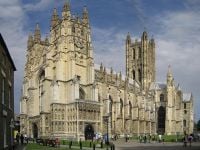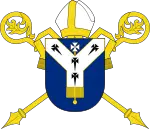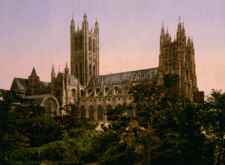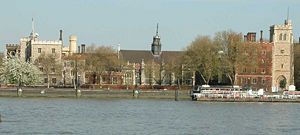Difference between revisions of "Archbishop of Canterbury" - New World Encyclopedia
| Line 2: | Line 2: | ||
The '''Archbishop of Canterbury''' is the chief bishop and principal leader of the [[Church of England]], the symbolic head of the worldwide [[Anglican Communion]] and the diocesan [[bishop]] of the Diocese of Canterbury, the see that churches must be in communion with in order to be a part of the Anglican Communion. The current archbishop is [[Rowan Williams]]. He is the 104th in a line that goes back more than 1400 years to [[Augustine of Canterbury|St Augustine of Canterbury]], who founded the oldest [[Diocese|see]] in England in the year 597. From the time of St Augustine until the sixteenthth century, the Archbishops of Canterbury were in full communion with the [[Roman Catholic Church]]. During the [[English Reformation]] the church broke away from the authority of the [[Pope]] and the Roman Catholic Church, at first temporarily and later more permanently. Since then they have been outside of the succession of the Roman Catholic Church's hierarchy and have led the independent national church. | The '''Archbishop of Canterbury''' is the chief bishop and principal leader of the [[Church of England]], the symbolic head of the worldwide [[Anglican Communion]] and the diocesan [[bishop]] of the Diocese of Canterbury, the see that churches must be in communion with in order to be a part of the Anglican Communion. The current archbishop is [[Rowan Williams]]. He is the 104th in a line that goes back more than 1400 years to [[Augustine of Canterbury|St Augustine of Canterbury]], who founded the oldest [[Diocese|see]] in England in the year 597. From the time of St Augustine until the sixteenthth century, the Archbishops of Canterbury were in full communion with the [[Roman Catholic Church]]. During the [[English Reformation]] the church broke away from the authority of the [[Pope]] and the Roman Catholic Church, at first temporarily and later more permanently. Since then they have been outside of the succession of the Roman Catholic Church's hierarchy and have led the independent national church. | ||
| − | In the [[Middle Ages]] there was considerable variation in the nomination of the Archbishop of Canterbury and other [[bishop]]s. At various times the choice was made by the [[Canon (priest)|canon]]s of [[Canterbury Cathedral]], the [[King of England]], or the Pope. Since the English Reformation, the [[Church of England]] has been more explicitly a [[state church]] and the choice is legally that of the [[British crown]]; today it is made in the name of the Sovereign by the Prime Minister, from a shortlist of two selected by an ''ad hoc'' committee called the [[Crown Nominations Commission]]. Successive archbishops have given distinguished leadership to the Church and to the nation. In the second half of the twentieth century, they enthusiastically embraced [[ecumenism]] and [[ | + | In the [[Middle Ages]] there was considerable variation in the nomination of the Archbishop of Canterbury and other [[bishop]]s. At various times the choice was made by the [[Canon (priest)|canon]]s of [[Canterbury Cathedral]], the [[King of England]], or the Pope. Since the English Reformation, the [[Church of England]] has been more explicitly a [[state church]] and the choice is legally that of the [[British crown]]; today it is made in the name of the Sovereign by the Prime Minister, from a shortlist of two selected by an ''ad hoc'' committee called the [[Crown Nominations Commission]]. Successive archbishops have given distinguished leadership to the Church and to the nation. In the second half of the twentieth century, they enthusiastically embraced [[ecumenism]] and [[Inter-religious Dialogue]] |
==Present roles and status== | ==Present roles and status== | ||
| Line 59: | Line 59: | ||
*Joint President, [[Historic Churches Preservation Trust]] | *Joint President, [[Historic Churches Preservation Trust]] | ||
*Director, [[Canterbury Diocesan Board of Finance]] | *Director, [[Canterbury Diocesan Board of Finance]] | ||
| + | |||
| + | The Archbishop of Canterbury is also a President of Churches Together in England (the ecumenical council). | ||
==Origins== | ==Origins== | ||
Revision as of 06:39, 19 January 2009
| Part of a series on Anglicanism | |

| |
| Organization | |
|---|---|
|
Anglican Communion | |
| Background | |
|
Christianity | |
| People | |
|
Henry VIII | |
| Liturgy and Worship | |
|
Book of Common Prayer | |
The Archbishop of Canterbury is the chief bishop and principal leader of the Church of England, the symbolic head of the worldwide Anglican Communion and the diocesan bishop of the Diocese of Canterbury, the see that churches must be in communion with in order to be a part of the Anglican Communion. The current archbishop is Rowan Williams. He is the 104th in a line that goes back more than 1400 years to St Augustine of Canterbury, who founded the oldest see in England in the year 597. From the time of St Augustine until the sixteenthth century, the Archbishops of Canterbury were in full communion with the Roman Catholic Church. During the English Reformation the church broke away from the authority of the Pope and the Roman Catholic Church, at first temporarily and later more permanently. Since then they have been outside of the succession of the Roman Catholic Church's hierarchy and have led the independent national church.
In the Middle Ages there was considerable variation in the nomination of the Archbishop of Canterbury and other bishops. At various times the choice was made by the canons of Canterbury Cathedral, the King of England, or the Pope. Since the English Reformation, the Church of England has been more explicitly a state church and the choice is legally that of the British crown; today it is made in the name of the Sovereign by the Prime Minister, from a shortlist of two selected by an ad hoc committee called the Crown Nominations Commission. Successive archbishops have given distinguished leadership to the Church and to the nation. In the second half of the twentieth century, they enthusiastically embraced ecumenism and Inter-religious Dialogue
Present roles and status
Today the archbishop fills four main roles:[1]
- He is the diocesan bishop of the Diocese of Canterbury, which covers the east of the County of Kent. Founded in 597, it is the oldest see in the English church.
- He is the metropolitan archbishop of the Province of Canterbury, which covers the southern two-thirds of England.
- As Primate of All England, he is the senior primate and chief religious figure of the Church of England (the British sovereign is the "Supreme governor" of the church). Along with his colleague the Archbishop of York he chairs the General Synod and sits or chairs many of the church's important boards and committees; power in the church is not highly centralized, however, so the two archbishops can often lead only through persuasion. The Archbishop of Canterbury plays a central part in national ceremonies such as coronation of the British monarch; thanks to his high public profile, his opinions are often in demand by the news media.
- As spiritual leader of the Anglican Communion, the archbishop, although without legal authority outside England, is recognized by convention as primus inter pares ("first among equals") of all Anglican primates worldwide. Since 1867 he has convened more or less decennial meetings of worldwide Anglican bishops, the Lambeth Conferences. However, the wider Anglican communion play no role in the appointment of a new archbishop.
In respect of the last two of these functions, he has an important ecumenical and interfaith role, speaking on behalf of Anglicans in England and worldwide.
The Archbishop's main residence is Lambeth Palace in the London Borough of Lambeth. He also has lodgings in the Old Palace, Canterbury, located beside Canterbury Cathedral, where The Chair of St. Augustine sits.
As holder of one of the "five great sees" (the others being York, London, Durham and Winchester), the Archbishop of Canterbury is ex officio one of the Lords Spiritual of the House of Lords. He is one of the highest-ranking men in England and the highest ranking non-royal in the United Kingdom's order of precedence.
Since Henry VIII broke with Rome, the Archbishops of Canterbury have been selected by the English (British since the Act of Union in 1707) monarch. Today the choice is made in the name of the Sovereign by the prime minister, from a shortlist of two selected by an ad-hoc committee called the Crown Nominations Commission. Since the twentieth century, the appointment of Archbishops of Canterbury conventionally alternates between Anglo-Catholics and Evangelicals.
The current archbishop, the Most Reverend and Right Honourable Rowan Douglas Williams, is the 104th Archbishop of Canterbury. He was enthroned at Canterbury Cathedral on 27 February 2003. As archbishop he signs himself as + Rowan Cantuar. Immediately prior to his appointment to Canterbury he was the Bishop of Monmouth in Wales. Whilst at Monmouth he was later, for a shorter period, also the Archbishop of Wales.
Additional roles
In addition to his office, the Archbishop also holds a number of other positions; for example, he is Joint President of the Council of Christians and Jews in the UK. Some positions he formally holds ex officio and others virtually so (the incumbent of the day, although appointed personally, is appointed because of his office). Amongst these are:
The Archbishop of Canterbury is also a President of Churches Together in England (the ecumenical council). OriginsIt has been suggested that the Roman province of Britannia had four archbishops, seated at London, York, Lincoln, and Cirencester.[2] However, in the 5th and 6th centuries Britannia began to be overrun by pagan, Germanic peoples who came to be known collectively as the Anglo-Saxons. Of the kingdoms they created, Kent arguably had the closest links with European politics, trade and culture, due to the fact that it was conveniently sited for communication with the Continent. In the late 6th century, King Æthelberht of Kent married a Christian Frankish princess named Bertha, possibly before becoming king, and certainly a number of years before the arrival of the first Christian mission to England.[3] He permitted the preaching of Christianity. The first Archbishop of Canterbury was |St. Augustine, who arrived in Kent in 597 C.E., having been sent by Pope Gregory I on a mission to the English. He was accepted by King Æthelbert, on his conversion to Christianity, in about the year 598. It seems that Pope Gregory, ignorant of recent developments in the former Roman province, including the spread of the Pelagian heresy, had intended the new archiepiscopal sees for England to be established in London and York. In the event, Canterbury was chosen instead of London, owing to political circumstances.[4] Since then the Archbishops of Canterbury have been referred to as occupying the Chair of St. Augustine. Before the break with Papal authority in the 16th century, the Church of England was an integral part of the continental Western European Church. Since the break the Church of England, an established national church, still considers itself part of the broader Western Catholic tradition as well as being the "mother church" of the worldwide Anglican Communion, though no longer in communion with the See of Rome. Province and Diocese of CanterburyThe Archbishop of Canterbury exercises metropolitical (or supervisory) jurisdiction over the Province of Canterbury, which encompasses thirty of the forty-four dioceses of the Church of England, with the rest falling within the Province of York. The four dioceses of Wales were formerly also under the Province of Canterbury until 1920 when they were transferred from the established Church of England to the disestablished Church in Wales. The Archbishop of Canterbury has a ceremonial provincial curia, or court, consisting of some of the senior bishops of his province. The Bishop of London—the most senior cleric of the church with the exception of the two archbishops—serves as Canterbury's Provincial Dean, the Bishop of Winchester as Chancellor, the Bishop of Lincoln as Vice-Chancellor, the Bishop of Salisbury as Precentor, the Bishop of Worcester as Chaplain and the Bishop of Rochester as Cross-Bearer. Along with primacy over the Archbishop of York, the Archbishop of Canterbury also has a precedence of honour over the other archbishops of the Anglican Communion. He is recognised as primus inter pares, or first amongst equals. The Archbishop of Canterbury, however, does not exercise any direct authority in the provinces outside England. At present the archbishop has four suffragan bishops:
Styles and privilegesBoth the Archbishops of Canterbury and York are styled "The Most Reverend"; retired archbishops are styled "The Right Reverend." Archbishops are, by convention, appointed to the Privy Council and may, therefore, also use "The Right Honourable" for life (unless they are later removed from the council). In formal documents, the Archbishop of Canterbury is referred to as "The Most Reverend Father in God, Forenames, by Divine Providence Lord Archbishop of Canterbury, Primate of All England and Metropolitan." In debates in the House of Lords, the archbishop is referred to as "The Most Reverend Primate, the Archbishop of Canterbury." "The Right Honourable" is not used in either instance. He may also be formally addressed as "Your Grace" - or, more often these days, simply as "Archbishop," "Father" or (in the current instance) "Dr Williams." The surname of the Archbishop of Canterbury is not always used in formal documents; often only the forenames and see are mentioned. The archbishop is legally entitled to sign his name as "Cantuar" (from the Latin for Canterbury). The right to use only a title as a legal signature is only permitted to bishops and Peers of the Realm. The current Archbishop of Canterbury usually signs as "+ Rowan Cantuar." In the order of precedence, the Archbishop of Canterbury is ranked above all individuals in the realm, with the exception of the Sovereign and members of the Royal Family.[5] Immediately below him is the Lord Chancellor, and then the Archbishop of York. The Archbishop of Canterbury's official residence in London is Lambeth Palace. Until the 19th century there were also major residences at Croydon Palace and Addington Palace. At one time there was also a palace in Maidstone in Kent, now called the Archbishop's Palace. There are ruins of another former palace at Otford in Kent. Lambeth DegreesThe Archbishop of Canterbury has the authority to confer degrees. Before the reformation, the papal legate had this power. In 1553, the British parliament passed an enabling Act allowing the Archbishop to continue this practice. This authority was renewed under the 1988 Education Reform Act. He awards doctorate and masters degrees. The former, usually in divinity, music or letters are not considered honorary but recognize achievements equivalent to an earned degree. Masters are also awarded in the same way or may be earned by thesis. The Archbishop also awards the S.Th. diploma. This is by examination or for a thesis. Graduates, by tradition, wear the academic dress of the University of which the which the current archbishop's alma mata. Until the appointment of George Carey, the 103rd archbishop, this had always been Oxford or Cambridge. He was a University of London graduate but chose Oxford regalia for those on whom he conferred degrees. Some Outstanding Incumbents
Given that the appointment of the Archbishop has a political aspect, it is not surprising that some outstanding men who might have been appointed were passed over. One such man was George Bell, whose criticism of the saturation bombings of Germany during World War II is said to have cost him translation from Chichester. FutureAs Britain becomes increasingly multi-cultural and pluralist, debate has taken place about whether it is appropriate for the Archbishop of Canterbury and for other senior bishops to continue to serve in the House of Lords. Recent archbishops have supported interfaith dialogue and and sponsor an annual interfaith lecture, established by the 101st archbishop, Frederick Donald Coggan. The archbishops have supported making space for representatives of other faiths in military and hospital chaplaincies and well as on radio and television. However, Anglican bishops are the only people who automatically sit in the Lords by virtue of their office (since, 1999 most hereditary peers no longer sit in the house.) There are peers who actively belong to other faiths and to other Christian denominations but with some exceptions, they have been appointed because of their achievements in other fields. When consulted about extending membership to other office holders some people object based on their preference for the complete separation of church and state, or of religion and the state. The bishops themselves have "consistently supported an expansion of the upper house to include Jewish, Sikh and Muslim members."[7] The government has resisted automatic representation of leaders of other faiths because of practical obstacles, such as the large number of denominations and faiths.[8] An Archbishop of Canterbury without a seat in the Lords might have less moral authority and less opportunity to speak on social and other important issues. However, the senior Catholic bishop in England, the Archbishop of Westminster, who does not sit in the Lords still attracts media attention for his views and opinions. Some view the spiritual lords as an anachronism, given the small percentage of people who attend any church. Others would be happy to see distinguished religious service as one criterion alongside others, such as service to the arts, to education, to medicine and to sport for appointment to the chamber, if it continues to consist if appointees and does not become an elected chamber. In contrast to the reserved seats held by bishops in the Lords, until 2001, clergy of the Church of England could not sit in the House of Commons.[9] Might a future Archbishop of Canterbury be chosen by the whole Anglican community? Originally, the Archbishop of Canterbury had jurisdiction over overseas diocese. Over time, this authority was relinquished. For example, when the diocese of Madras was founded in 1835, the Archbishop ceded metropolitan authority to the Bishop of Calcutta.[10] Or, might the the link between the Primate of the Anglican Community and the Archbishop of Canterbury be surrendered in favor of an elected Primate of the whole communion? References
|


